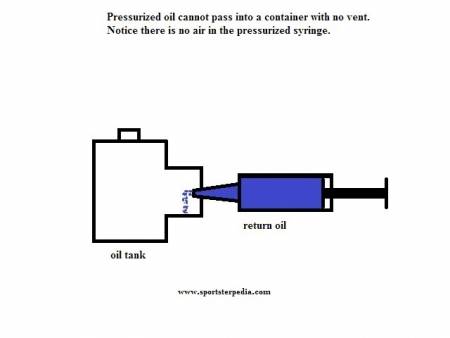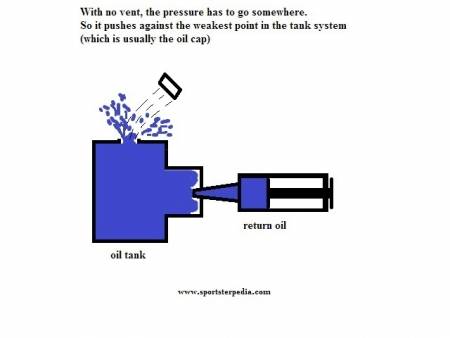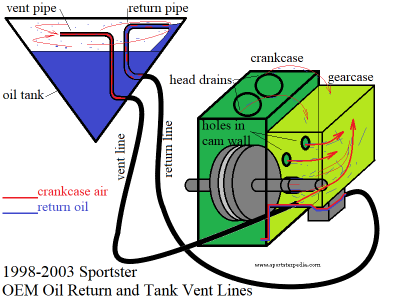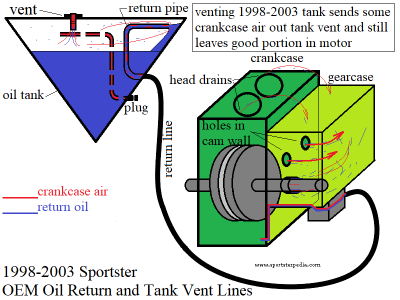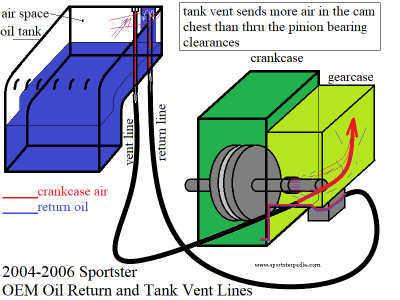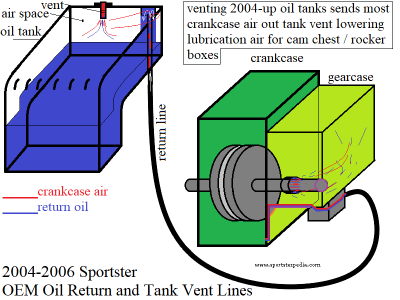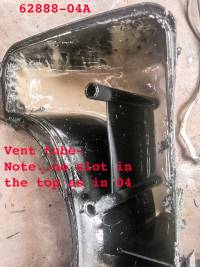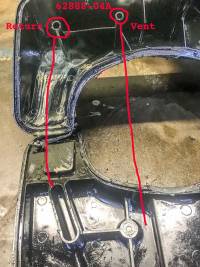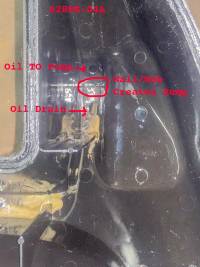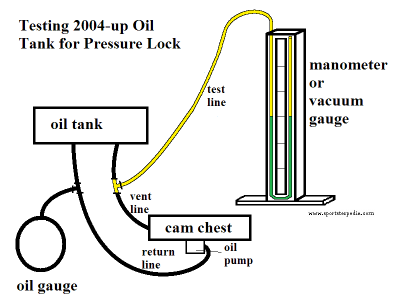Table of Contents
REF: Oiling & Lubrication
Oil Tank Pressure
See also, Oil Tank Head Pressure in the Sportsterpedia.
There should not be any noticeable pressure in the oil tank due to the generated pressure being vented back into the cam chest. 1)
Because you can't physically pump more oil out of your motor than you pump in, the larger return pumps air also. 2)
(in addition to the return oil in order to make up the volume difference).
You will see this if you remove the cap off the oil tank and start the motor.
The return oil enters the tank in spurts with the air in between the spurts.
This in turn means more volume gets put back into the tank from the return side than gets removed from the tank by the supply side.
So the tank gets pressurized and that cant be allowed to happen.
It's the vent line's job to allow that extra air volume to exit the tank and go back to where it came from, the gearcase.
During normal operation;
With the tank cap / dipstick removed, tank pressure is vented to atmosphere from the top of the tank.
With the tank cap / dipstick installed, tank pressure is vented to the cam chest.
During shutdown;
The oil tank vent is connected to the cam chest and the cam chest is vented out the breather valve(s) in the cam cover or heads, respectively.
So if you have pressure in your oil tank and the vent to the cam chest is not blocked then the cam chest is also pressurized.
If the cam chest is holding pressure, then your breather valve(s) can not be venting properly.
Bottom line is that if the vent system is working properly, you shouldn't have excessive pressure build up in the oil tank. 3)
Conditions where oil seeps or spews from the oil tank include;
- Blocked oil tank vent line / hose.
- The vent line being blocked will keep the pressure in the tank until it builds enough to blow out the cap.
- 2004-2009 plastic tanks have a vent / return tube design problem inside the tank.
- Blocked / stopped up crankcase breather vent.
- With blocked or non-working breather(s), engine performance will also suffer.
- Too much oil in the engine, oil tank or both. 4)
- Check your FSM or owners manual for the proper amount of oil to add.
- Sportsters are known for wet sumping (condition where oil from the tank seeps into the engine while not running).
- Once the engine is started, the oil pump scavenge georotors will return the engine's sump oil back to the tank.
(in theory, at a rate faster than the feed gerotors can send oil to the engine from the tank on a warmed up engine) - There are conditions that would slow the speed at which oil returns to the tank however.
Too much standing oil in the sump added to worn oil pump internals, condition of the pressure relief valve and oil filter can slow the pump's ability to clear the sump. - Oil can drain down into the motor from the tank for a number of reasons when it has been sitting for a long time.
Then, the dipstick will give a false reading because some of that oil went into the engine. - If you already have 1-2 quarts seep down the feed line and into the engine and then add more to the oil tank,
the excess oil will either blow out the breather valve(s) or the oil tank.- Oil level should only be checked or added to with a warmed engine as per the FSM.
- If you're not sure of the collective amount of oil in the system (as in buying a used bike), drain the engine and oil tank and refill with the proper amount.
(when draining cold oil, you will not get all of the existing oil to drain out of the engine)
So, it may be better to drain and add the proper amount minus a half quart, run it up to temp and recheck, then add some more if needed. - You may not be able to see or access the sump drain plug as it may be blocked by the frame.
- 86-91 engines have a pressure relief valve set at 30-35 psi.
During a cold start, the pressure relief will dump unfiltered oil into the gearcase until the oil heats up enough (lowering oil pressure) and the relief valve closes.
Likewise, repeated start/stops before allowing the oil to heat up will dump more oil into the engine faster than the scavenge pump can return it to the oil tank.
- Oil lines not routed to the correct fittings.
- If you've removed or replaced your oil lines, double check that they are connected to the right fittings.
- Replacing the hollow head breather bolts for regular ones. 5)
- On 91-up engines, installing a regular bolt in place of the OEM hollow bolts can cause this issue.
- That would block crankcase pressure up in the engine and cause degradation of engine performance.
- If upgrading to an aftermarket A/C, you must account for an alternate method to vent crankcase pressure if you're not using the OEM hollow bolts.
- A plugged up oil filter should not cause this issue.
- All spin on oil filters have a pressure relief valve built into them.
- It is designed to still deliver (unfiltered) oil to the engine in the case of blockage of the filter media at no extra pressure increase.
- Oil tank blew up in cold weather. 6)
- 04-up models have plastic oil tanks. The belief is that some moisture gets frozen in the vent line on 04-09 tanks causing the rupture.
- It's a plastic tank so it is not going to be anything like a pressure cooker if it does happen, just messy.
- The worst of it is replacing all the parts (and not being able to ride while waiting for parts to arrive).
- The newer upgraded tanks have a better venting design to prevent this.
- In 2010, the MoCo put a 10 psi relief valve in the oil tank (presumably to prevent this sort of issue).
- The relief valve will help prevent having to replace the oil tank.
- The cause for plastic oil tanks leaking has been discussed in the XLForum. See this link to that discussion. We may have discovered the root cause.
Also see 2004-Up Oil Tank Leak Issue below for the bulk of that conversation. - This has happened to a handful of XLFORUM members (statistically, a pretty small number).
- But there are plenty of riders who have ridden in below freezing temperatures that haven't had a problem.
Crankcase Pressure / Venting the Oil Tank
Air Pressure and Oil Level
Air inside the tank doesn't get there because of CC pressure alone. Ambient air resides in the upper portion of the tank above the oil level.
The air was there first. Then the oil was added. If you add too much oil, there will be even less air in the tank.
This would result in a need to move crankcase pressure out of the tank faster to keep up with incoming pressure.
A lower oil level in the tank would facilitate more area for CC pressure to collect before venting out.
Some have claimed that lowering the oil level in the tank reduces wet sumping.
There may some truth to that in the short run for reasons above.
But that is more like using a band-aid to cover a more important underlying condition of too much total crankcase pressure.
That condition doesn't just go away when you lower the oil level.
There should be a variant oil level in the tank depending on many factors.
The displacement of ambient air and CC pressure in the tank relies on the engine breather vent(s).
If the engine can't breath, the system locks up. However, it may be compounded due to air/oil separation once there.
In the drawings below, a syringe is used to example crankcase pressure being applied into the oil tank:
Since it's not the oil pump scavenger's job to separate the oil/air mist, both crankcase pressure and oil end up in the oil tank. 9)
So one function of the oil tank is to allow for air to separate out of the oil once there. 10)
The oil falls to the bottom while the air separates from the oil and goes into the tank vent back to the crankcase.
From there, the air gets circulated out the engine breather vent(s) and back into the intake to burn off hydrocarbons.
(or sometimes re-circulated into the scavenger passage)
So, in essence, the oil tank acts as an oil / air separator like the breather valve but the air only expels the engine from the engine's breather vent.
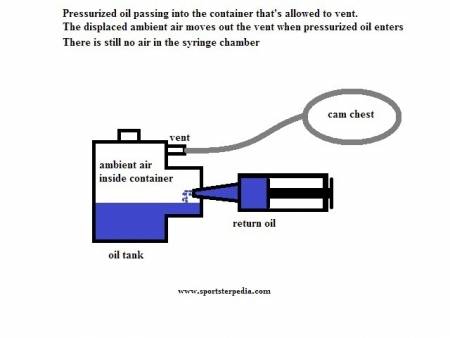 11)
11)
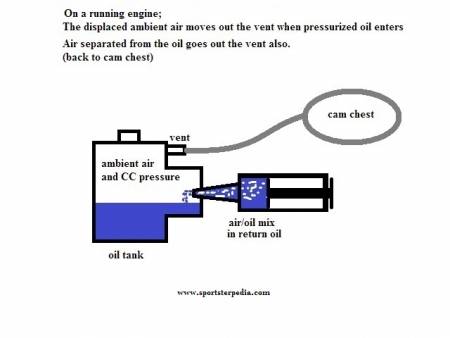 12)
12)
The piston movements in the HD engine are not in apposing positions to balance out the displacement of air.
They are mounted on the same crank pin and oscillate into a small volume crankcase.
Crankcase air pulses from a pressure condition to a vacuum condition inside the engine.
With the pistons movements being so close together, air is pushed and then pulled with each piston's up and down stroke.
This 'push-pull' condition affects oil scavenge from the engine to the oil tank.
Crankcase pressure and oil is both pushed towards and pulled from the scavenger passage in the sump.
Likewise, so is pressure to and from the oil tank.
As far as the oil tank is concerned, picture blowing up a balloon halfway, then letting the air out and repeating.
On one hand, you can picture both oil and CC pressure being pushed to and from the oil tank.
On the other, the oil pump scavenger creates more flow pressure than the force of CC pressure.
So one could also see that as the oil pump sends oil/air to the tank on piston down stroke and negative (vacuum) pressure pulls air back thru the vent.
See more here Evo Crankcase Pressure on engine breathing, crankcase pressure and blowby in the REF section of the Sportsterpedia.
Stopped Up Vent Line
If the oil tank vent line is plugged up, the oil pump will still send air/oil pressure into the tank.
The air pressure can't leave the tank but the oil is recirculated from the tank into the engine by the feed side of the pump.
Pressure will build in the tank until the cap blows, oil leaks from the cap or the oil tank splits (plastic).
You still have the same amount of pressure on the engine side of the plugged up vent line.
And that pressure is still being vented out the engine breather(s) as normal.
However, a plugged vent line will hinder oil pump scavenging.
This will result in less oil going to the tank and more oil gathering in the sump waiting to be scavenged.
And that can lead to wetsumping with more oil in the sump than usual.
Removing the Oil Cap with the Engine Running
Removing the oil cap on a hot idling engine (so far rigid S models only), may lower engine speed if the breather valve(s) aren't working properly. 13)
An example on a 98 1200S with oil temp 210°F, idle was raised to 1200 RPM and 700 RPM was lost.
So the exact power loss is variable but true.
With new umbrella valves installed, the RPM did not change with the oil cap off.
This is the same as having a bad breather valve opening but not closing.
Oil doesn't puke out the tank since higher density suspension oil comes up the return line from the sump.
The suspension fluid and return oil together in the line separates by the time it reaches the vented tank.
(leaving most of what comes out the top of the oil tank to be air).
The bulk of air / oil mist is generated in the crankcase, not the cam chest where the vent line to the tank is.
The higher air/oil density drags the flywheels and more oil is picked up in suspension with the engine breathing both in and out.
The engine responds at idle from the higher load on the wheels.
Read more on Fluid Drag above.
Venting the Oil Tank
The oil tank is by design, vented to the cam chest and out the engine breather vent(s).
Neither the oil cap nor the oil tank should be vented without a one way check valve.
The tank is vented to the cam chest on purpose to remove condensate (that gets pumped in) from the oil tank out the single one way engine breather valve.
Venting the oil tank \ cap also will negatively influence crankcase pressure by letting in extra air.
1/2 of the return flow is air because the return pump is twice as big as the feed pump. 14)
That air is full of condensate. A slightly negative (to atmospheric) pressure in the tank facilitates vaporization of the condensate.
- 1977-2003 Sportsters use oil pump scavenge and the oil tank to remove some of the crankcase air into the cam chest.
However, there are also holes in the cam walls for crankcase air to escape into the cam chest and head drains to the crankcase.
These holes carry crankcase air out to the cam chest without using the oil pump.
The oil pump does still have bigger feed gerotors that will pick up crankcase air to the oil pump also.
But the crankcase is not bottled up like 2004-up motors.
- 2004-Present Sportsters use oil pump scavenge and the oil tank to move most of the crankcase air into the cam chest.
Some goes out the pinion shaft bearing clearances but the only other outlet for piston downstroke air is the oil pump.
The source of air intake to the crankcase on piston upstroke is the pinion shaft bearing clearance.
The oil pump is steadily pushing oil and air out of the crankcase into the oil tank and then into the cam chest / rocker boxes to the head vents.
Oil Tank's Role vs Wetsumping
There should not be any pressure difference in the oil tank than the engine although it does transfer pressure.
The oil tank vent line to the cam chest allows the pump to send oil and CC pressure to the tank without over pressurizing the inside.
It is not there to vent the cam chest, the breathers do that.
 19)
19)
During normal operation;
With the tank cap / dipstick removed, tank pressure is vented to atmosphere from the top of the tank.
With the tank cap / dipstick installed, tank pressure is vented to the cam chest.
So if you have pressure in your oil tank and the vent to the cam chest is not blocked then the cam chest is also pressurized.
If the cam chest is holding pressure, then your breather valve can not be venting properly.
Bottom line is that if the vent system is working properly, you shouldn't have excessive pressure build up in the oil tank. 20)
It has been said by many that lowering the oil level in the oil tank will stop oil puking out the breather.
While this may work in application, by design, you should not have to lower the oil level.
This practice is not just restricted to rubbermounts although due to the CC pressure change in 04, it is a more accepted practice.
The tank acts as an oil / air separator like the breather valve but the air only expels the engine from the engine breather vent. 21)
Lowering the oil level in the tank
*When you lower the oil level in the tank, you are just masking the real problem* .
Below are some arguments for lowering the oil level with responses below them.
Basically myths and truths.
*The answer is to address the air/oil density in the system or other areas needing attention, not the oil level in the tank.*
- It has been said that The oil vent line in the oil tank is too close in height to the full mark.
- The vent line is actually higher than the full mark.
- If the engine breathers are working properly, the oil level in the tank should never get high enough to enter the vent line.
- If there is an engine breathing problem,
The tank vent will not flow separated air back into the cam chest fast enough to keep up with the incoming flow of oil in the tank. - The oil / air backs up in the tank, but pressure is steadily coming up the scavenge line from the pump.
- Aerated oil will take up more space volume than non-aerated oil.
- Then the result could be oil (backed up) running back down this vent line into the cam chest during operation (acceleration and braking).
- It has been said that The extra oil in the bottom end is thrown around more inside the engine and finds it's way up into the heads during the breathing operation.
This excess oil is then purged out the head breathers.
- Any oil that leaves the vent in the oil tank flows back into the cam chest then gets scavenged via the cam chest port in the pump.
- All oil in the cam chest can be subject to being picked up into suspension no matter of it's origin.
- It has been said that Having too much oil in the tank will cause more blowby.
- Too much oil in the tank does not cause more blowby. 22)
- Oil in the engine must:
- 1. Lube
- 2. Clean
- 3. Cool
- If you take away what the factory says to run then you take away from one or all of those 3 properties.
- Blowby is a condition when air pressure blows by the rings or valves.
- Blowby has some to do with oil puking out the breathers, but it doesn't cause it by itself.
- Oil puking out the breathers is an imbalance in the breathing system which may or may not have to do with the rings or valves.
- The oil level only matters if the tank has been overfilled past the top mark on the dipstick. 23)
- This is easy to do if you check the oil level and fill the tank BEFORE heating up the engine to operating temperature.
See more about Over filling the oil tank in the REF section of the Sportsterpedia. - Overfilling the oil tank can bring the level up over the vent to the crankcase.
This would stop up the vent to the cam chest, over-pressurize the tank and hinder scavenging from the sump.
Increased sump oil (not able to be scavenged fast enough) aides in oil suspension or air /oil density increasing crankcase pressure.
Increased crankcase pressure aides in oil puking out the vents.
- It has been said that Running the oil level on the bottom dipstick line helps curb blowby.
Running the oil level at the middle to high side of the dipstick causes more blowby.
- Running the oil level on the low mark of the stick effectually lowers the amount of oil that would collect in the sump.
- It also lowers the amount of oil circulating which could raise oil temps and starve mechanical parts of oil.
(I.E. lifters, rockers, bearings etc.) - Lowering the amount of oil in the sump also leaves less oil there to get pulled up into suspension which thins out air / oil mist.
- It's the more dense air / oil mist that is the problem, not the oil level in the tank.
- Many people say that it is important to leave plenty of empty space in your oil tank. 24)
- If you don't have excess crankcase pressure, you don't have to do that. You can fill the oil tank to the full mark on the dipstick without any issue.
- The oil tank is a sealed space with a seal / O-ring on the dipstick.
The oil tank space is connected to the crankcase space via the vent hose that runs from the oil tank to the cam cover.
By filling the oil tank only half full, you create a larger air volume in the crankcase space itself.
This increased air volume can help buffer the pressure in an engine with only a slight problem with blow-by gasses combined with the restricted head vents. - However, if you either;
- Restore your engine to like new low levels of blow-by.
- Or if you improve the engine's ability to vent the pressure.
Then you don't need the extra buffer space provided by half filling your oil tank.
You can go ahead and fill your tank with the proper amount of oil.
Which means you have more oil to circulate through the engine which is a good thing.
2004-Up Oil Tank Leak Issue
The 2004-2009 oil tanks have had many problems with the seam between the top and bottom section leaking.
Some have noticed this only during cold temperatures and some have had this problem at warmer temps.
But a cracked oil tank is not just restricted to those years as -04B and 2010-up tanks with the oil pressure relief have also been known to crack / leak.
The 2004-2006 factory installed oil tank (62888-04) seems to have the worst problems.
The vent tube rises up into a receiving hole in the top section of the tank. It is still taller than the return tube.
But the receiving hole acts as a cap on the end of the vent tube and there are two small slots in that receiving hole as air inlets to the vent tube from the tank.
These little slots are what the tank “breaths” into and the air is routed back to the cam chest. 03-earlier tanks do not restrict the vent tube inlet like this.
Additional factors in the design are the return tube is placed near the vent tube inside and on the left (shallow) side of the tank.
The left side is the more shallow part of the design as the right side is deeper and holds most of the oil.
And finally there are partitions molded into the inside of the tank (baffles for aeration control, structural aids or both).
If the oil is cold enough, it may not flow past those baffles fast enough to clear out that compartment on the left where the two tubes are.
If the cold oil level reaches the vent, it can't escape out the vent fast enough due to oil thickness.
Then the oil level builds in that left compartment where the vent also resides, pressure builds and pops the tank seam.
The return gerotors are bigger than feed gerotors in the oil pump. It should return oil faster to the tank than it feeds oil to the engine from the tank.
If you have sumped oil in the crankcase, that will be sent to the oil tank faster than more oil can leave the tank from the feed side.
(that's true in any Sportster)
But, 03-earlier tanks allow the whole tank to be utilized for dumping oil back into from the return tube.
04-up apparently only allow that one compartment to receive return oil first until the oil runs past the baffles.
So thicker oil or wetsumping may be the secondary contributing factor for blowing the tank seam due to the prime contributing factor of poor inner tank construction.
When the oil level rises in the left compartment, the vent tube is not going to take a full flow of the oil back thru the vent to the cam chest due to the small inlet slots.
The vent hose won't get blocked full of oil. The oil will seal the vent tube off in the tank by hydraulic lock and not allow the air to leave the tank.
Then the pressure builds in the tank (oil pump is pressurizing the return hose but the vent would now be blocked).
The pressure should not be sent to the cam chest / engine since the vent tube would now be blocked.
The 2007-2009 oil tank (62888-04A) has a wider trough in the top section that the vent tube rises up into (the slot system was deleted).
This allowed the tank to breath back to the cam chest faster and with less effort.
But the baffles (or partitions) are still there to slow the oil down from running to the right side and down into the sump area.
So it's only a slight improvement. Thicker oil can still pool in that shallow left compartment and hydro-lock the vent tube.
In late 2009, the MoCo released a new oil tank version (62888-04B) for 2004-2009 models. It has the 10 psi relieve valve that is standard on the 2010 oil tank.
The MoCo also moved the return tueb to the right side and got it away from the vent tube completely.
Yet still, the 10 PSI relief valves will open even in the later upgraded oil tanks.
10 PSI is very high for crankcase pressure but the 10 PSI valve in the tank isn't the whole story.
The pump is capable of making 100 PSI (either the feed or return side) and probably much more when the vent is blocked.
So if the vent is hydro-locked with oil, tank pressure could get very high and that's when you may end up blowing the cap off or cracking the tank seam.
To recap:
2004-2006 had the 62888-04 tank - worst problem.
2007-2009 had 62888-04A - still a problem but the vent is less restrictive.
In late 2009, the 62888-04B was released for 2004-2009 models. - it has the 10 psi relieve valve and is an improvement from previous versions.
The 2010 oil tank had an even better design as they moved the return tube to the right (deeper) side of the tank and installed a 10 PSI relief valve.
04-06 Oil Tank (62888-04) Internals
The pic below is an 04-06 oil tank with the top and bottom separated. You can see how high the oil has to rise to get to the vent tube.
Oil basically has to fill up the small compartment from the left side to the first baffler first.
Click on a pic to enlarge: 25)
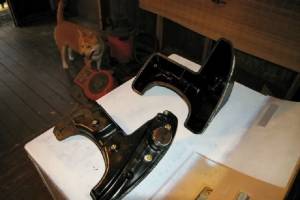
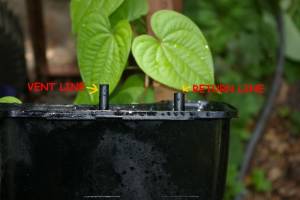
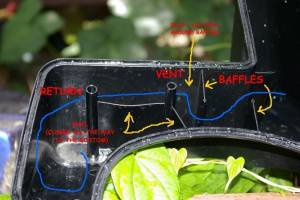
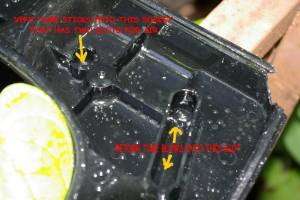
07-09 Oil Tank (62888-04A) Internals
Here is the 07-09 oil tank cut open.
You can see the partitions (or baffles) and that the vent area in the top section has been widened out and the slot is gone.
You can also see the emulsion (mayo) on the left side of the tank.
With the bike on the stand, the small cavity allows that amount of oil to cool faster than if it were all lumped in with the sumped area on the right.
When you got a few quarts of hot oil pooled in the tank, it takes longer for it to cool. And the air has more time to gas off.
With oil staying in that smaller cavity by itself, it cools faster and the air emulsifies with the oil.
Next startup/heat cycle, the air in emulsion should burn off after the oil gets to operating temp.
Click on a pic to enlarge: 26)
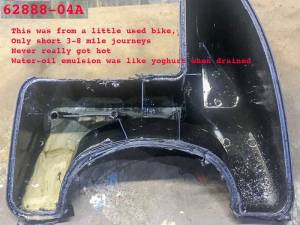
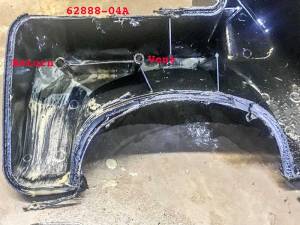
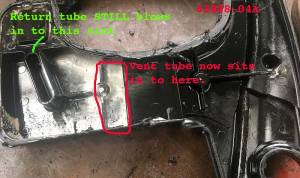
Testing 2004-up oil tank for hydro-lock
The plastic oil tank can be tested during operation to see if oil is blocking the vent tube.
This way, you'll know if it is the oil tank or the bottom end that needs to be addressed.
By installing a manometer or a vacuum gauge to monitor crankcase pressure and an oil gauge to measure return pressure, it can be deduced as;
- If the oil gauge pressure rises but the manometer doesn't change or doesn't change a lot, the oil tank is being pressurized.
- If the water blows out the open end of the manometer, the tank is not holding pressure and it's the crankcase air that is too high.
(you won't retain any water in a 3 foot manometer if the pressure reaches 1.5 PSI) - If crankcase pressure is high on an Hg pressure gauge, same as with the manometer. The tank isn't being pressurized.

